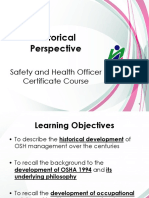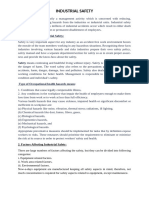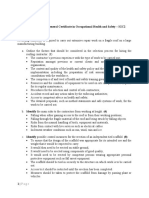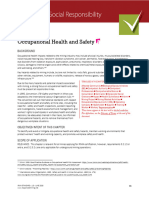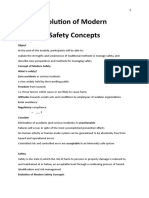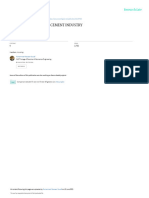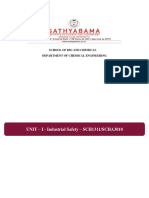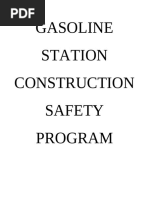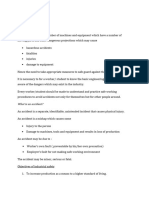Safety Issues and Environmental Impact
Safety Issues and Environmental Impact
Uploaded by
Noor FatihahCopyright:
Available Formats
Safety Issues and Environmental Impact
Safety Issues and Environmental Impact
Uploaded by
Noor FatihahOriginal Title
Copyright
Available Formats
Share this document
Did you find this document useful?
Is this content inappropriate?
Copyright:
Available Formats
Safety Issues and Environmental Impact
Safety Issues and Environmental Impact
Uploaded by
Noor FatihahCopyright:
Available Formats
7.
0 Safety issues and environmental impact
7.1 Detail safety considerations
In plant, safety consideration is the most important thing to taken care.
There are some aspects of safety which are site, plant layout, process
design and design stages. The health and safety at work (Act 1974) The
health and safety at work (Act 1974) provided a new legal administrative
framework to promote, simulate and encourage even higher standards
of health and safety at work. In chemical plant, the main hazards are
toxic and corrosive chemicals, explosions, fires and accidents common
to all industrial activities. The most important and crucial part of a plant
is a healthy and safe working environment for the workers and people
involved. The safety of materials and equipment can be control from
knowing the safety information for every materials and equipment used
in the plant (McLellan et al., 1995).
a) Plant safety
In plant, there are many factors influencing the safety of the
plant especially for the company that manufacture chemical product in
their plant. The factors are:
I. Chemical storage
Chemical storage in plants is very essential because it
has an enormous quantity of raw material and the
product with the chemical used for other processes such
as washing, water treatment and waste treatment.
II. Transportation
There are some factors linked to job in the handling of
chemicals within the plant for transportation. Workers
involved in managing the transport of chemicals such as
tanker lorry or forklift drivers must follow all handling
processes because they are the ones who are in charge
of moving the products on site and therefore indirectly
rely on them for the safety of other employees.
III. Plant location
The plant location for chemical plant needs to be located
far from the residential fields to minimize the hazards or
likelihood of harming the public in any manner possible
for the plant place. In plants, usually occurring accidents
are linked to the cloud of fire, explosion, or vapour. All of
these variables can influence individuals and the
environment in a major disaster.
b) Workers safety
There are some basic safety rules for the workers which must
be observed when working in all chemical-manufacturing areas. Below
are some of the rules:
I. Always observed all safety regulations in the plant
II. All accidents have to be reported to the supervisor
instantly.
III. All staff are liable for the safety and security of their
colleague.
IV. The places of work must be clean and tidy to ensure
that no failure occurs.
V. Deficient equipment, unsafe circumstances and
unsafe procedures shall be reported to your
supervisor as quickly as they have been identified.
VI. Matches and lighters must not be brought into the
plant and left in the lockers space.
VII. Always wear the right Personal Protective
Equipment (PPE)
VIII. No smoking is allowed in the site
c) Personal Protective Equipment (PPE)
Employers are responsible for supplying and using Personal
Protective Equipment (PPE) at job. PPE is equipment that protects the
user from workplace health or safety hazards. It can include items such
as safety helmets, gloves, eye protection, high-visibility clothing, safety
footwear and safety harnesses. It also involves protective devices for
the Respiratory Protective Equipment (RPE).
I. Safety Helmets
A hard hat is a type of helmet predominantly used in
workplace environments such as industrial or construction
sites to protect the head from injury due to falling objects,
impact with other objects, debris, rain, and electric shock.
II. Dust mask
There are now many types available, all of which provide
protection against damaging dust inhalation. Special
absorbent pads are covered with a perforated metal disc or
fitted to a molded rubber facepiece: the pads should be
changed regularly and after use the facepiece should be
cleaned. Most importantly, the dust masks do not give any
gas protection.
III. Air mask
The most popular air masks are the "army gas mask" sort:
with adjustable elastic straps fitting around the head, a
molded rubber front with two eye ports is kept face to face.
Air is taken from a canister attached to the body through a
flexible hose and a non-return valve in front of the mouth and
expelled between the lips and the mask's rubber sides. The
canister includes an appropriate, absorbent material and
therefore distinguishing the right canister for the
circumstances to be entered is of essential significance.
IV. Safety footwear
In industry, a steel-toe boot (also known as a safety boot,
steel-capped boot or safety shoe) is a durable boot or shoe
that has a protective reinforcement in the toe which protects
the foot from falling objects or compression, usually
combined with a mid-sole plate to protect against punctures
from below.
d) Emergency procedure
An emergency is an unplanned event that has the potential to harm
the life, health, or safety of a person, or to damage the environment or
public property (Incident Management and Reporting Guidelines, n.d.).
If there is emergency in the plant, below is the following procedures
should be followed:
1) Do not panic and stay alert
2) Assess the situation around the area
3) Wait for instructions from supervisor or shift manager
4) Avoid using the telephone
I. Fire protection
The significant hazard in chemical industries are fires that will
proceed to an explosion if any. Therefore, it is mandatory to
have any fire extinguisher medium available as such water
supplies, fireman and hydrants and foam.
1. Portable fire extinguisher - should be situated close enough
to the hazard to be accessible instantly, but far enough to
avoid the fire from using it.
2. Thermal and optical sensors - used to detect unseen fires
operating in two ultraviolet and infrared spectral areas.
3. Fire detection systems-should provide a quick and reliable
indication of fire presence, place, and size.
II. Instrument Protective System
1. Air Monitoring and Alarm - used to detect and quantify
airborne levels of hazardous substances and risks to safety
and health to determine the suitable amount of on-site
protection for employees.
2. Leak Detection Systems – give warning of exceeding the
worst permissible situation. To specify dangerous levels,
visual alarms should be intended in the scheme.
3. Emergency valves - All valves must be accessible for
emergency operation.
III. Maintenance and Inspection
It is essential to perform adequate maintenance to prevent the
pitfalls or breakdown of the plant's tools or machinery.
1. Continuous training is vital for high-pressure plants.
Mechanics and supervisors must bear the ongoing
knowledge of working on the specific equipment learning
process.
2. Maintenance and operations should be distinct functions
with the common goal of ensuring the plant's secure,
constant and profitable operation, but with main attention
concentrated differently–equipment maintenance and
process operation.
3. The organisation should include structured technical staff so
that they can concentrate their efforts on the maintenance
elements of technical problem-solving.
e) Health Hazard Materials
I. Sulphur
Based on the Safety Data Sheet (SDS), if ignited by
spark or flame, sulphur will burn in air yielding oxides of sulphur.
This means that any air suspended Sulphur dust in the plant is
at risk of ignition from flame, static or friction spark. When
handling Sulphur, it is suggested to use spark-resistant
instruments, nonferrous conveyor parts etc. Formation of
sulfuric acid mist should be avoided by exposure of sulphur
trioxide to water vapor. In case of accumulation of Sulphur dust
in a particular section of the plant, the area classification must
be adhered too.
Steam may be added to a molten Sulphur tank's vapor
headspace during storage as a type of blanketing to displace
any air (and therefore oxygen) present. In case of a fire in molten
sulphur small to medium storage tanks, splashing of sulphur is
preferred to water, as steam formation could pressurize the
confined space within a storage tank. However, a good spray or
water fog is preferred for bulk storage tanks of molten sulphur.
It is suggested that carbon dioxide fire extinguishers combat
sulphur fires
II. Oxides of Sulphur
Very toxic sulphur dioxide inhalation is considered fatal
or at least causes excessive nose and throat irritation. Skin
contact damages skin comparable to sulfuric acid and direct
contact with liquefied gas if sulphur dioxide can freeze or chill
the skin. Effects on contact with eyes etc. have comparable
implications to prior materials. Workers, like Sulphur Dioxide,
may be prone primarily through inhalation and skin contact. It
may take time to detect toxic impacts.
In the sector, personal protective equipment in the form
of respirators, respiratory equipment (for emergencies), dust-
tight glasses (Sulphur handling areas), safety lenses with side
shields (Molten Sulphur storage areas), face shields, fire
retardant garments, heat-resistant gloves (Sulphur molten
storage area) are used based on data collected on safety
aspects (Klosowski, Schaffrath, & Seifert, 2009).
f) Transportation and storage
Sulfuric acid is categorized as a flammable solid from a transport view
and the appropriate sign should be displayed on the transport. In bulk
storage fields, the sign can also be presented. Chemicals transportation
is controlled by government agencies to guarantee that minimum
requirements are met with regard to the equipment and processes used
with the ultimate objective of protecting the general public. Relevant
information should be displayed in the container label. There are
labelling techniques for hazardous materials. A sample label whose
content is consistent with the Globally Harmonized Chemicals
Classification and Labelling of Chemical (GHS) is provided below. The
U.S. apex body dealing with industrial safety, the Occupational Health
and Safety Administration has made it compulsory to display such
labels during the storage and transport of chemicals such as sulfuric
acid. Another federal agency that issues safety standards in the US, the
National Fire Protection Agency (NFPA), also deals with safety
elements. The NFPA triangle shows the health (blue), flammability (red)
and reactivity (yellow) hazard presented by a chemical and another
chemical-specific hazard (Kumareswaran, 2013).
7.2 Environmental Impact analysis
In order to ensure that there is no spillage in the river or other
locations that can be harmful to human or other living items, the
environment also needs to be considered. This chemical product cannot
be tossed into the drain and must be prevented from entering the public
sewer or releasing to the environment. Next, ensure that this material
and its container are disposed of in a dangerous or special waste
collection that are according to the Hazardous Waste Regulation. The
other environmental elements are the place strategies. The plant must
be far away from the institutional or residence. This is because the gas
released from the plant is a dangerous gas that can influence people or
other living things (Kim & Chae, 2016). Below shows the environmental
impact analysis:
a) Waste disposal/ management
Due to the acids produced, the manufacturing of sulfuric acid
can be dangerous to humans and the environment. For the treatment
of sulphuric acid, the effluent treatment is required. According to
(Cavallini, 2016), the following steps should generally be followed by all
effluent treatment techniques: impurity precipitation, solid separation
from fluid, and pH adjustment. In addition, neutralization is another
easiest way to treat a weak effluent of acid. The addition of calcium
hydroxide is required to form the calcium sulphate or gypsum in order
to neutralize the sulphuric acid. In addition, calcium hydroxide is the
least costly neutralizing agent available for the treatment of an acidic
effluent.
b) Noise
For noise pollution, the sources of noise in plant is coming from
equipment itself during the processing of plant which may exceed the
local decibel limit. The noise produced by the plant could render the
surrounding area uncomfortable as it could be regarded as noise
pollution.
c) Workplace Exposure
Those that working with sulphuric acid tend to expose to the
chemical hazard either in manufacturing operations or in other process
that deal with this product. It is because this product will undergo many
processes such as packaging, sampling and testing. So, the possibility
for the workers to expose to the chemical is higher. Engineering
modifications to the process equipment should be suggested inside the
plants in order to reduce the emissions to the acceptable levels.
d) Emission to the environment
Due to the release of compounds such as sulphur dioxide into
the atmosphere and mixing with water, oxygen and other chemicals,
sulphuric acid can cause acid rain to the surroundings. Then, in clouds,
fog or rain, the acid particles dissolve to create acid rain. Other than
that, it also provides the aquatic life with mild acute toxicity (Likens,
2004).
Cavallini, S. (2016). Handbook on chemical and, (January).
Executive, S. (n.d.). Your mask can protect you – Stay healthy !
Incident Management and Reporting Guidelines. (n.d.). Retrieved from
https://staff.uow.edu.au/content/groups/public/@web/@ohs/documents/doc/uow
016969.pdf
Kim, T. H., & Chae, C. U. (2016). Environmental impact analysis of acidification and
eutrophication due to emissions from the production of concrete. Sustainability
(Switzerland), 8(6), 1–20. https://doi.org/10.3390/su8060578
Klosowski, V., Schaffrath, A., & Seifert, U. (2009). Plant safety.
https://doi.org/10.1007/978-3-540-88546-7_101
Likens, G. (2004). What Is Acid Rain?. Science and Children, 42(3), 52. Retrieved
from https://www.epa.gov/acidrain/what-acid-rain
McLellan, J. A. S., Barrow, B. A., Levy, J. C., Hammersley, M. S., Hattersley, A. T.,
Gillmer, M. D. G., & Turner, R. C. (1995). Prevalence of diabetes mellitus and
impaired glucose tolerance in parents of women with gestational diabetes.
Diabetologia, 38(6), 693–698. https://doi.org/10.1007/BF00401841
Respiratory protection guide. (n.d.).
Sales, M. P., & Box, P. O. (2009). MATERIAL SAFETY DATA SHEET - MSDS
Sulfuric Acid ( Concentrated ), (August), 1–8.
You might also like
- Sea Ray SPX 210 Owners Manual ENDocument52 pagesSea Ray SPX 210 Owners Manual ENTerrence JonesNo ratings yet
- Iso - CD 10377Document46 pagesIso - CD 10377aTaciturn100% (1)
- Construction Manpower SafetyDocument5 pagesConstruction Manpower SafetyEM Simon75% (8)
- Annexure - A Construction Safety SOPDocument10 pagesAnnexure - A Construction Safety SOPANUJ SHAH100% (1)
- On Site Emergency Response Plan: Creative Textile Mills Privae LimitedDocument28 pagesOn Site Emergency Response Plan: Creative Textile Mills Privae LimitedMuntaj Ansari75% (4)
- NORSOK Z-008 Risk Based Maintenance & Consequence ClassificationDocument44 pagesNORSOK Z-008 Risk Based Maintenance & Consequence ClassificationWilkin Llanca Blas100% (2)
- Niosh Sho M1M2M3M4Document2,399 pagesNiosh Sho M1M2M3M4Jerry Walter100% (2)
- J&J Risk Based Exposure Assessment ProcessDocument9 pagesJ&J Risk Based Exposure Assessment ProcessBulent InanNo ratings yet
- Industrial Safety Notes First ModuleDocument59 pagesIndustrial Safety Notes First ModulePRASAD ACHARINo ratings yet
- Industrial Safety Notes-1Document36 pagesIndustrial Safety Notes-1Aarush Mohan100% (1)
- Garmet Notes L4Document42 pagesGarmet Notes L4bonifacesinamenyeNo ratings yet
- Industrial Safety Final PPTDocument28 pagesIndustrial Safety Final PPTNitishNo ratings yet
- 008 A Nuñez Ma - ChristinaDocument5 pages008 A Nuñez Ma - Christinanunezmachristina.aitechNo ratings yet
- Accident Proneness-Definition Causes Prevention & BenefitsDocument11 pagesAccident Proneness-Definition Causes Prevention & BenefitsAman GautamNo ratings yet
- NTA 8 Site Mgt-3notesDocument33 pagesNTA 8 Site Mgt-3notesEmmanuel NamkumbeNo ratings yet
- SG-18 Personal Protective Equipment (PPE) ManagementDocument13 pagesSG-18 Personal Protective Equipment (PPE) ManagementMohamedNo ratings yet
- Management Chapter 4 Study MaterialDocument26 pagesManagement Chapter 4 Study MaterialVirendra PatilNo ratings yet
- Safety in Eng Industry AssignmentsDocument18 pagesSafety in Eng Industry Assignmentsrahul.rathor0304No ratings yet
- Health and Safety in Cement Industry: June 2022Document7 pagesHealth and Safety in Cement Industry: June 2022shibanand.pandaNo ratings yet
- Ope353 Unit I and IIDocument50 pagesOpe353 Unit I and IIrrajajcb0% (1)
- NotesDocument7 pagesNotesaaaaaaaaaaaaaaaaaaaaaaaaaaaaaaaNo ratings yet
- EssayDocument3 pagesEssaySHASHA VALINo ratings yet
- 2010 JuneDocument7 pages2010 JuneShahlaNo ratings yet
- 4 E's of Accident PreventionDocument23 pages4 E's of Accident Preventionanamayank111No ratings yet
- Environmental and Health Safety StepsDocument18 pagesEnvironmental and Health Safety StepsAltaf Ur RehmanNo ratings yet
- SC-18 Personal Protective Equipment - PPE - ManagementDocument9 pagesSC-18 Personal Protective Equipment - PPE - ManagementgpscletscrackNo ratings yet
- Chapter 3.2 Occupational HSDocument7 pagesChapter 3.2 Occupational HSRina FebrianaNo ratings yet
- Environmental Health and Safety: Group 7Document12 pagesEnvironmental Health and Safety: Group 7Luis ArcillNo ratings yet
- Ncs - Core Abilities Level 1Document45 pagesNcs - Core Abilities Level 1nadia natashaNo ratings yet
- Chapter 3Document33 pagesChapter 3Emmanuel NamkumbeNo ratings yet
- Employee Safety Manual-9Document8 pagesEmployee Safety Manual-9A SNo ratings yet
- Industrialsaftyfinal 200529052521Document29 pagesIndustrialsaftyfinal 200529052521Karthic MannarNo ratings yet
- Workshop Safety AwarenessDocument14 pagesWorkshop Safety AwarenessSAJANA WIJETHUNGENo ratings yet
- Internal Memo: Hazrds and Unsafe Working ConditionsDocument4 pagesInternal Memo: Hazrds and Unsafe Working ConditionsAsad AwanNo ratings yet
- Soil Lab Safety Equipment - Basic - Technical - EnglishDocument12 pagesSoil Lab Safety Equipment - Basic - Technical - EnglishPatzel J. Vallejos DíazNo ratings yet
- Safety ProgramDocument10 pagesSafety ProgramAmmanda ErnawanNo ratings yet
- Workshop Full NotesDocument110 pagesWorkshop Full NotesTanasha WayneNo ratings yet
- CONTRACTORS CONSTRUCTION SAFETY AND HEALTH PROGRAM ForDocument4 pagesCONTRACTORS CONSTRUCTION SAFETY AND HEALTH PROGRAM ForJohannes Gregorii LagueNo ratings yet
- Evolution of Modern Safety ConceptsDocument16 pagesEvolution of Modern Safety ConceptsMuhammad Arif0% (1)
- Comprehensive Safety and Health Program ConstructionDocument15 pagesComprehensive Safety and Health Program ConstructionNina CaliwagNo ratings yet
- PM AssignmentDocument3 pagesPM AssignmentAiswarya RajkumarNo ratings yet
- Health and Safety in Cement IndustryDocument7 pagesHealth and Safety in Cement Industryوائل شديوةNo ratings yet
- Construction Safety-Midterm Exam (MODIFIED) - GENEROSODocument5 pagesConstruction Safety-Midterm Exam (MODIFIED) - GENEROSOFranz Anfernee Felipe GenerosoNo ratings yet
- 2.1 Basic Safety PracticesDocument10 pages2.1 Basic Safety PracticesBsvk DupanaNo ratings yet
- Safety in Cleaning of Chemical Storage Tanks Using Job Safety Analysis MethodsDocument2 pagesSafety in Cleaning of Chemical Storage Tanks Using Job Safety Analysis MethodsAnonymous izrFWiQNo ratings yet
- Bench WorkDocument38 pagesBench Workdannyjbmahire1No ratings yet
- Scha 3010Document106 pagesScha 3010AFEC AGIRONo ratings yet
- Industrial Safety and Hazard ManagementDocument89 pagesIndustrial Safety and Hazard ManagementRoshanNo ratings yet
- SafetyDocument7 pagesSafetyJisha KuruvillaNo ratings yet
- Contruction Safety and Health Program - AmdocsDocument21 pagesContruction Safety and Health Program - AmdocsRonald DolorNo ratings yet
- Module 4 - Unit 1Document14 pagesModule 4 - Unit 1abhishek17071No ratings yet
- AMA International University of Bahrain First Tri-Semester (2017-2018) Safety Engineering (ENGG500) MCDocument18 pagesAMA International University of Bahrain First Tri-Semester (2017-2018) Safety Engineering (ENGG500) MCSreedev Vijayan PillaiNo ratings yet
- BSC Day 2 Unit 1Document10 pagesBSC Day 2 Unit 1Saqib AbbasiNo ratings yet
- SAFETY PROGRAMDocument16 pagesSAFETY PROGRAMvalientenitzNo ratings yet
- DR REYpdfDocument4 pagesDR REYpdfSean Ben KadusaleNo ratings yet
- A. Major Causes of Construction Site AccidentsDocument6 pagesA. Major Causes of Construction Site AccidentsAlyzza Mae AngkahanNo ratings yet
- Safty Quisten Micro For ExternalDocument10 pagesSafty Quisten Micro For ExternalDBZ ShotsNo ratings yet
- Notes Safety For WorkshopsDocument11 pagesNotes Safety For Workshopschileshelombe0No ratings yet
- Safety in Process Plants: Presented by Group 2. CHE 522 Supervised by Prof. K. OBAHIAGBONDocument24 pagesSafety in Process Plants: Presented by Group 2. CHE 522 Supervised by Prof. K. OBAHIAGBONsunlias100% (1)
- Health and Safety PowerpointDocument27 pagesHealth and Safety Powerpointmoses.m1901272No ratings yet
- Workshop Safety PracticesDocument63 pagesWorkshop Safety Practicesjpneshuku796No ratings yet
- Managing Health and Safety at WorkplaceDocument13 pagesManaging Health and Safety at WorkplaceHarshit AhelaniNo ratings yet
- IS Unit 1Document25 pagesIS Unit 1Ishwarya ManivannanNo ratings yet
- ctm4 Lesson 1&2Document37 pagesctm4 Lesson 1&2laurencelucero10No ratings yet
- The Handbook of Safety Engineering: Principles and ApplicationsFrom EverandThe Handbook of Safety Engineering: Principles and ApplicationsRating: 4 out of 5 stars4/5 (1)
- Variability Among Living Organisms From All Sources: Importance Ways To Preserve and Conserve Animals and PlantsDocument1 pageVariability Among Living Organisms From All Sources: Importance Ways To Preserve and Conserve Animals and PlantsNoor FatihahNo ratings yet
- Natural FibreDocument9 pagesNatural FibreNoor FatihahNo ratings yet
- Question1 (TPP)Document1 pageQuestion1 (TPP)Noor FatihahNo ratings yet
- Assignment Society (T)Document5 pagesAssignment Society (T)Noor FatihahNo ratings yet
- Assignment 1 InnoDocument10 pagesAssignment 1 InnoNoor FatihahNo ratings yet
- Parameter For Selection Production BriquetteDocument4 pagesParameter For Selection Production BriquetteNoor FatihahNo ratings yet
- Assgnmnt Society DGN NashDocument9 pagesAssgnmnt Society DGN NashNoor FatihahNo ratings yet
- Chapter 2 - PGM - GuideDocument13 pagesChapter 2 - PGM - GuideNoor FatihahNo ratings yet
- Result: Table: Change After Adding 1.0 ML of 1M HCL and 1.0 ML of 1M Naoh To Deionized Water and The Buffer SolutionDocument1 pageResult: Table: Change After Adding 1.0 ML of 1M HCL and 1.0 ML of 1M Naoh To Deionized Water and The Buffer SolutionNoor FatihahNo ratings yet
- Sungai Udang LandfillDocument9 pagesSungai Udang LandfillNoor FatihahNo ratings yet
- GHOCSDocument2 pagesGHOCSNoor FatihahNo ratings yet
- EXxx OMN0038 CDocument49 pagesEXxx OMN0038 Clin zhangNo ratings yet
- MS-Excavation Backfilling-Transco PowerDocument26 pagesMS-Excavation Backfilling-Transco PowerfirozembrayilNo ratings yet
- Laboratory Safety SymbolsDocument5 pagesLaboratory Safety Symbolskate2494100% (1)
- A New Approach On Implementing TPM in A Mine - A Case Study: SciencedirectDocument12 pagesA New Approach On Implementing TPM in A Mine - A Case Study: SciencedirectMaysa Martha100% (1)
- MECAPRO Ang - ADocument99 pagesMECAPRO Ang - ASergei Mosolov100% (1)
- Nut Bolt Tighten by Hammering Spanner and Torque Machine JsaDocument4 pagesNut Bolt Tighten by Hammering Spanner and Torque Machine JsaAKBAR ALI100% (1)
- Statement On Core ValuesDocument12 pagesStatement On Core ValuesSneha bNo ratings yet
- Chapter 1a - OSHA Electricity SafetyDocument60 pagesChapter 1a - OSHA Electricity SafetyGopinath SubramaniNo ratings yet
- Alicorp Quality Management SystemsDocument17 pagesAlicorp Quality Management SystemsScribdTranslationsNo ratings yet
- Wynn's Hand Cleaning Paste: Safety Data SheetDocument6 pagesWynn's Hand Cleaning Paste: Safety Data SheetAsadNo ratings yet
- Master List of DocumentsDocument1 pageMaster List of DocumentstriveshNo ratings yet
- FlammablesDocument12 pagesFlammablesSafety ManagerNo ratings yet
- Ucua 31.10.22Document51 pagesUcua 31.10.22fiq nightmareNo ratings yet
- Risk Assessment ELPDocument13 pagesRisk Assessment ELPAmitha RanjithNo ratings yet
- Risk Assessment - Chapter 1Document26 pagesRisk Assessment - Chapter 1Alexandre Hugen50% (2)
- New Supplier Survey FormDocument14 pagesNew Supplier Survey Formsutharitessh100% (1)
- r41041rgv10 First Aid Reference GuideDocument72 pagesr41041rgv10 First Aid Reference GuideEnekwa VictoriaNo ratings yet
- 97 Glass Removal and Replacement-JOB PROCEDUREDocument2 pages97 Glass Removal and Replacement-JOB PROCEDURESarfarazNo ratings yet
- FANUCS10 MaintDocument708 pagesFANUCS10 MaintNhan Pham AnNo ratings yet
- Safety and Health Management System Plan and Procedure For C-Line (Draft) Apr-14Document34 pagesSafety and Health Management System Plan and Procedure For C-Line (Draft) Apr-14MR. MANTU DWIVEDINo ratings yet
- SIIT ReportDocument50 pagesSIIT ReportAnderson JoeNo ratings yet
- ISO 22000:2005 Food Safety Management Systems Auditor/Lead Auditor Training CourseDocument153 pagesISO 22000:2005 Food Safety Management Systems Auditor/Lead Auditor Training CourseYasser Hassan100% (1)
- Manual TR420 enDocument38 pagesManual TR420 enMari Sherlin Salisi-ChuaNo ratings yet
- 5867EN-1 Maint ManualDocument46 pages5867EN-1 Maint ManualChabane OubarecheNo ratings yet
- MSDS Docusate SodiumDocument7 pagesMSDS Docusate SodiumLi QiNo ratings yet






